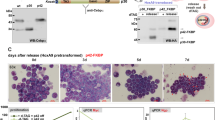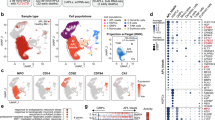Abstract
Acute promyelocytic leukemia (APL) is a human cancer generated by a chromosomal translocation t(15;17) involving the promyelocytic leukemia (PML) and retinoic acid receptor alpha (RARα) genes. The PML/RARα oncoprotein expressing blasts show two of the most important biological features of neoplastic progression: block of differentiation, at the promyelocytic state, and increased survival. Although PML/RARα interferes with the normal maturation of myeloid precursors to granulocytes, pharmacological doses of retinoic acid are sufficient to restore the differentiation processes.
We designed an assay based on the Real-Time reverse transcriptase polymerase chain reaction (RT-PCR) to experimentally follow the differentiation response of leukemic cells even after short-time differentiating treatments. Amplifying CD11b, CD11c, and CD14 mRNAs, as specific markers of differentiation, by the real-time RT-PCR assay we could detect both retinoic acid (RA) and vitamin D3 and human transforming growth factor β1 (VitD3/TGFβ1) induced cellular maturation more precociously than the canonical flow-cytofluorimetric assay. Moreover, by amplifying CD14 mRNA it was possible to monitor the ability of PML/RARα oncoprotein to block VitD3/TGFβ1 induced differentiation in U937-PR9 promonocytic inducible model systems.
The proposed real-time quantitative RT-PCR approach is a reproducible and highly sensitive assay and can be considered a valid method to study both cellular maturation state and differentiation response.
Similar content being viewed by others
References
Alcalay, M., Zangrilli, D., Pandolfi, P. P., et al. (1991) Translocation breakpoint of acute promyelocytic leukemia lies within the retinoic acid receptor alpha locus. Proc. Natl. Acad. Sci. USA 88, 1977–1981.
Goddard, A., Borrow, J., Freemont, P., and Solomon, E. (1991) Characterization of a zinc finger gene disrupted by the t(15;17) in acute promyelocytic leukemia. Science 254, 1371–1374.
Kakizuka, A., Miller, W. J., Umesono, K., et al. (1991) Chromosomal translocation t(15;17) in human acute promyelocytic leukemia fuses RAR alpha with a novel putative transcription factor PML. Cell 66, 663–674.
Warrel, R. P. Jr., de The, H., Wang, Z. Y., and Degos, L. (1993) Acute promyelocytic leukemia. N. Engl. J. Med. 329, 177–189.
Grignani, F., Fagioli, M., Alcalay, M., et al. (1994) Acute promyelocytic leukemia: From genetics to treatment. Blood 83, 10–25.
Chomienne, C., Fenaux, P., and Degos, L. (1996) Retinoid differentiation therapy in promyelocytic leukemia. FASEB J. 10, 1025–1030.
Grignani, F. R., Ferrucci, P. F., Testa, U., et al. (1993) The acute promyelocytic leukemia-specific PML/RARα fusion protein inhibits differentiation and promotes survival of myeloid precursor cells. Cell 74, 423–431.
Nervi, C., Ferrara, F. F., Fanelli, M., et al. (1998) Caspases mediate retinoic acid-induced degradation of the acute promyelocytic leukemia PML/RARα fusion protein. Blood 92, 2244–2251.
Fanelli, M., Minucci, S., Gelmetti, V., Nervi, C., Gambacorti-Passerini, C., and Pelicci, P. G. (1999) Constitutive degradation of PML/RARα through the proteasome pathway mediates retinoic acid resistance. Blood 93, 1477–1481.
Higuchi, R., Dollinger, G., Walsh, P.S., and Griffith, R. (1992) Simultaneous amplification and detection of specific DNA sequences. Biotechnology (NY) 10, 413–417.
Lanotte, M., Martin-Thouvenin, V., Najman, S., Ballerini, P., Valensi, F., and Berger, R. (1991) NB4, a maturation inducible cell line with t(15;17) marker isolated from a human acute promyelocytic leukemia (M3). Blood 77, 1080–1086.
Grignani, F., Testa, U., Rogaia, D., et al. (1996) Effects on differentiation by the promyelocytic leukemia PML/RARα protein depend on the fusion of PML protein dimerization and RARα DNA binding domains. Embo J. 15, 4949–4958.
Livak, K. J. and Schmittgen, T. D. (2001) Analysis of relative gene expression data using Real-Time quantitative PCR and 2(-Delta DeltaC(T)) method. Methods 25, 402–408.
Testa, U., Masciulli, R., Tritarelli, E., et al. (1993) Transforming growth factor-beta potentiates vitamin D3-induced terminal monocytic differentiation of human leukemic cell lines. J. Immunol. 150, 2418–2430.
Grignani, F., De Matteis, S., Nervi, C., et al. (1998) Fusion proteins of the retinoic acid receptor-a recruit histone deacetylase in promyelocytic leukaemia. Nature 391, 815–818.
Author information
Authors and Affiliations
Corresponding author
Rights and permissions
About this article
Cite this article
Caprodossi, S., Pedinotti, M., Amantini, C. et al. Differentiation response of acute promyelocytic leukemia cells and PML/RARα leukemogenic activity studies by real-time RT-PCR. Mol Biotechnol 30, 231–238 (2005). https://doi.org/10.1385/MB:30:3:231
Issue Date:
DOI: https://doi.org/10.1385/MB:30:3:231




